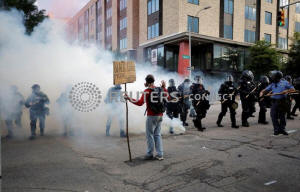Videos of alleged police misconduct went viral. Then what happened?
 Send a link to a friend
Send a link to a friend
 [June 23, 2020]
By Ted Hesson, Mimi Dwyer and Andy Sullivan [June 23, 2020]
By Ted Hesson, Mimi Dwyer and Andy Sullivan
(Reuters) - Some U.S. authorities have
moved with unusual speed to fire, suspend or charge police officers
caught on video hitting and pushing peaceful protesters and targeting
them with pepper spray during nationwide protests in recent weeks, a
Reuters review of 44 videos recorded during the demonstrations found.
Police investigations into alleged officer misconduct rarely result in
discipline, law enforcement experts said. And it is not uncommon for
fired officers to be reinstated through arbitration or to be hired by
other police agencies. Nationwide data on police discipline is limited,
the experts said.
The videos reviewed by Reuters were shot during demonstrations that
followed the death of George Floyd, a Black man killed by police
officers in Minneapolis on May 25. While hundreds of such videos have
been shared recently on social media platforms, Reuters focused on 44
that were widely circulated online. Nearly all the videos were shot by
protesters or bystanders.
Two of the incidents Reuters examined - in Atlanta and Louisville,
Kentucky - have led to police officers or chiefs losing their jobs.
Local district attorneys have pressed charges against four officers in
Atlanta, two officers in Buffalo, New York, one officer in New York City
and one officer in Philadelphia, the review found. Those officers were
also suspended.

In all, police departments said they were investigating or reviewing the
incidents shown in 35 of the videos, a tally that includes the videos
that led to officers being fired or charged with crimes. Officers were
put on desk duty, modified duty or given paid leave in at least six
instances.
(For an interactive version of this story, with video, see: https://tmsnrt.rs/3erXv4z)
The fact that the incidents were captured on video appears to have
increased the likelihood of officers being charged with a crime, which
is a rare occurrence, according to Christy Lopez, who worked in the
Civil Rights Division of the U.S. Department of Justice from 2010 to
2017. Lopez led the team that investigated the police department in
Ferguson, Missouri, after the 2014 killing of an unarmed Black teenager
by a white police officer.
“I have been reviewing written accounts of incidents like this for
decades, and often it is only when there is a video that there is any
chance of accountability, or even attention, regardless of how blatant
the police misconduct is,” said Lopez, now a professor at Georgetown
Law. “There is no question that video prompts action.”
The incident that sparked the protests – Floyd’s death at the hands of
the police – was captured by a bystander on a cellphone video that
lasted more than 10 minutes. Such footage can be more valuable for
investigations and prosecutions than officer-worn body cameras, which
provide a limited field of view, according Seth Stoughton, a law
professor at the University of South Carolina and a former police
officer.
Body-worn cameras can malfunction, he said, and officers sometimes fail
to activate them before an incident. Beyond that, people who view any
type of videos may disagree about the facts and what they mean.
Floyd's death led to protests in Minneapolis that spread to cities and
towns in all 50 states. While most of the protests have been peaceful,
some led to violence and looting. Thousands of people were arrested
across the country, including in New York, Los Angeles, Washington, D.C.
and other cities.
Four Minneapolis police officers have been fired and charged in
connection with the incident, including Derek Chauvin, the officer who
kneeled on Floyd's neck, killing him. Chauvin has been charged with
second-degree murder and manslaughter. The other three officers have
been charged with aiding and abetting in the case, and manslaughter.
None of the officers have been asked to enter a plea yet, according to
the state attorney general’s office.
Nationwide data on federal and state prosecutions related to police use
of force or other misconduct is limited, according to experts. Even less
is known about the number of instances where prosecutors considered
charges, but did not press them.
Rachel Harmon, director of the Center for Criminal Justice at the
University of Virginia School of Law, said video creates “a more even
playing field” when it comes to determining what happened during
incidents between police and the public.
She also said it humanizes people who are subject to alleged police
misconduct, which can make the viewer “more sympathetic to that person’s
suffering, even if that person is imperfect.” Public opinion polls show
Americans’ views on racism and police misconduct have shifted
dramatically in recent weeks compared with earlier surveys.
In one New York City case, New York Police Department (NYPD) officer
Vincent D’Andraia was charged with assault, menacing, and harassment for
throwing a protester to the ground. He has pleaded not guilty. A
supervisor was also disciplined and reassigned. In two other New York
City cases, two officers were referred for discipline, with one
suspended without pay and one reassigned.

The NYPD officer who was suspended was shown on video pulling down the
face mask of a protester who had his hands raised, then spraying that
protester with what appeared to be pepper spray. The officer who was
reassigned was seen opening the passenger side door of a moving police
vehicle so that it struck a protester.
NYPD only identified the officer who was charged. Police Benevolent
Association President Patrick Lynch said in a written statement to
Reuters that each officer was “entitled to due process and a full and
impartial investigation of the incident, not summary judgment based on a
few seconds of video.”
The 44 videos reviewed by Reuters show police pushing protesters to the
ground, throwing or shooting projectiles at them, and striking them with
batons or fists.
Ashley Heiberger, a retired officer from the Bethlehem Police Department
in Pennsylvania, said the videos likely do not include all the
information needed to judge an officer’s behavior. Heiberger now works
as an independent consultant advising police departments on policies,
training, accountability and the use of force.
“It’s not really possible to watch a video and make a determination
about whether it suggests misconduct without knowing the context,”
Heiberger said. “If you just see an officer applying force to a subject,
you have no idea why he’s doing that and the totality of circumstances.”
The videos involved at least 27 local law enforcement agencies, as well
as the U.S. Park Police and the District of Columbia and Kentucky
National Guard forces.
Officers have only been publicly identified in six of the 44 videos
reviewed by Reuters.
The footage appears to show at least 80 officers involved in the
incidents, according to an estimate by the news agency. In some cases,
particularly in instances where protesters were shot with bean bag
rounds and rubber bullets or sprayed with tear gas, it was unclear how
many officers may have been involved based on the video footage.
“BOLOGNA STRONG”
Two former law enforcement officers who reviewed the videos for Reuters
said that at least some of the officers appeared to be acting
inappropriately or that the nature of the incidents suggested the need
for further investigation.
[to top of second column]
|

A protester faces riot police advancing through tear gas
during nationwide unrest following the death in Minneapolis
police custody of George Floyd, in Raleigh, North Carolina,
U.S. May 30, 2020. Picture taken May 30, 2020.
REUTERS/Jonathan Drake

Former NYPD detectives John Baeza and Joseph Guida, who work
together and typically serve as expert witnesses in cases on behalf
of alleged victims of police misconduct, reviewed the videos and
found roughly half appeared to show inappropriate behavior. The
other cases lacked context or did not show the intent of the
officers, they said.
The city of Atlanta’s response to a May 30 altercation involving its
police force stands out among the incidents reviewed by Reuters
because officers were fired soon afterwards.
Body cameras worn by police showed officers breaking a window on a
car whose driver and passenger were college students, stunning them
with Tasers and pulling them from the vehicle.
Of the six officers allegedly involved, two were fired and four were
suspended the following day. On June 10, two more of the officers
were fired. Four of the officers were charged with aggravated
assault, a felony. The two other officers faced lesser charges.
Susan Hutson, who has been the independent police monitor for the
New Orleans Police Department since 2010, said prosecutions of law
enforcement for alleged misconduct were rare, and that she was
encouraged by the swift move to bring charges in cities such as
Atlanta.
Still, she said a prosecution is only one step in the process and
does not necessarily mean that an officer will be convicted.
“A lot of times juries don’t want to convict, and courts are
sympathetic as well to police officers,” Hutson said. “It can be
tough to keep them fired.”
Lance LoRusso, an attorney representing two fired Atlanta officers,
Ivory Streeter and Mark Gardner, said his clients did not use
excessive force and that the arrests were lawful. The two officers
filed a lawsuit that argues they were fired without due process and
should be reinstated and receive back pay.
The other officers could not be reached for comment.
Vince Champion, the southeast regional director of the International
Brotherhood of Police Officers, which represents all six officers
involved, said the district attorney’s office had acted too quickly
in charging the officers and that more time was needed to determine
whether misconduct occurred.
Heiberger, the former Pennsylvania police officer, said police
officers often have additional due process protections in state
statutes, city codes and union contracts. He said officers typically
must be given information about the allegations and the opportunity
to consult with a labor representative. They often get a chance to
review the evidence that supports those allegations, he said.
Heiberger said use-of-force investigations are serious matters that
involve interviews with all parties and the collection of relevant
evidence, which is then reviewed.
“While I don't know for certain how the Atlanta Police Department
conducts its internal operations, I'm skeptical that the required
investigative and adjudicative procedures could be completed in one
day,” he said, referencing the quick dismissal of the two officers
after the May 30 incident.

The police department and mayor’s office did not respond to requests
for comment over the firings and due process concerns.
Local prosecutors in other cities have filed charges, too.
The Philadelphia District Attorney’s Office charged Philadelphia
Police Staff Inspector Joseph Bologna with aggravated assault and
other crimes on June 5 after he was captured on video striking a
college student in the back of the head with a metal baton.
Philadelphia District Attorney Larry Krasner said in a written
statement announcing the charges that his office was “trying to be
fair” and that “accountability has to be equal.”
The local police union in that city has rallied around the accused
officer, selling T-shirts that read “Bologna Strong” and cheering
him as he left the union headquarters to surrender to authorities on
June 8.
Fortunato Perri, an attorney representing Bologna, told Reuters in
an email that the officer’s actions were justified.
“In the midst of this deadly pandemic, Inspector Bologna and his
fellow officers were spit on, sprayed with urine and other chemicals
as well as verbally and physically assaulted,” Perri said. “His use
of force to apprehend an individual, who was trying to thwart a
lawful arrest during a melee, was lawful and justified.”
Mayor Jim Kenney on May 30 lauded his city’s police force for
showing “restraint” during violent protests, saying they were spit
on and had urine and “caustic agents” thrown at them.
Reuters could not confirm whether Bologna was directly involved in
such incidents. His attorney did not respond to a request for
additional details.
One of the best-known videos features a 75-year-old protester in
Buffalo, New York, who appeared to be pushed to the ground by two
police officers during a June 4 demonstration.
In the video, Martin Gugino, a local activist, lay motionless on the
ground as blood seeped from his right ear. Kelly Zarcone, Gugino’s
attorney, told reporters afterward that Gugino had a fractured skull
and a brain injury. She confirmed the injuries to Reuters and said
on June 12 that he was not yet able to walk.
The two officers, who were part of the Buffalo Police Department’s
Emergency Response Team, were suspended without pay and arraigned on
felony assault charges.
New York Governor Andrew Cuomo said a day after the incident that he
had spoken with Gugino and was thankful he survived.
“You see that video and it disturbs your basic sense of decency and
humanity,” Cuomo said during a press briefing. “Why, why, why was
that necessary? Where was the threat?”

John Evans, president of the Buffalo police officers’ union, told
Reuters the charges “should never have been filed,” but did not
elaborate. Evans had previously told a local media outlet that the
officers were simply following orders.
(Reporting by Ted Hesson and Andy Sullivan in Washington and Mimi
Dwyer in New York; Editing by Ross Colvin and Marla Dickerson)
[© 2020 Thomson Reuters. All rights
reserved.] Copyright 2020 Reuters. All rights reserved. This material may not be published,
broadcast, rewritten or redistributed.
Thompson Reuters is solely responsible for this content. |